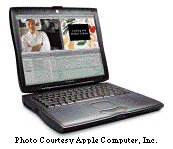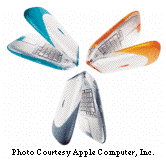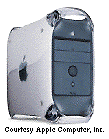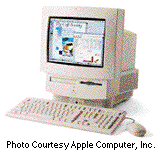With both Macworld San Francisco and Tokyo behind us, much of the
Macintosh lineup has received a facelift. The  PowerBook received a true revision with the introduction
of the much awaited "Pismo" line, available in
either 400 or 500 MHz configurations. Other improvements include
FireWire and AirPort support, along with a faster graphics chip.
PowerBook received a true revision with the introduction
of the much awaited "Pismo" line, available in
either 400 or 500 MHz configurations. Other improvements include
FireWire and AirPort support, along with a faster graphics chip.
MacWeek's Stephen
Beale noted of the new laptop line, "What it doesn't include is a
G4 processor--Apple says the current G4 design is too hot and too
power-hungry for laptops." As Low End Mac publisher Dan Knight stated, "...despite the hype
about the Velocity Engine...unless you have applications optimized for
the AltiVec instructions,  such as Photoshop 5.5, you won't see any significant benefit from
the G4 processor."
such as Photoshop 5.5, you won't see any significant benefit from
the G4 processor."
Staying with laptops, the successful iBook line now comes with 64
MB of RAM and a 6 gig drive over the previous 32 MB and 3.2 gig. A new
graphite Special Edition is also available with a 366 MHz G3 processor.
Pricing for the tangerine and blueberry laptops remained the same,
while the Special
Edition will retail at $1,799.
On the high end, Apple finally returned its G4 minitower offerings to the
400, 450, and 500 MHz  speeds
announced
last August without a price increase. While the speed bump was
needed, it pales in a world of 700 to 850 MHz Pentium III and Athlon chips. Apple and
its chip design partners have to get busy in the speed area, especially
for high end users, such as the graphics industry. For most of the rest
of us, the current megahertz speed contest is a lot like having an
automobile that can go 125 MPH. It's there, but we're probably
never going to use it.
speeds
announced
last August without a price increase. While the speed bump was
needed, it pales in a world of 700 to 850 MHz Pentium III and Athlon chips. Apple and
its chip design partners have to get busy in the speed area, especially
for high end users, such as the graphics industry. For most of the rest
of us, the current megahertz speed contest is a lot like having an
automobile that can go 125 MPH. It's there, but we're probably
never going to use it.
For educators, the recent expos were a good news, bad news
situation. The good news from the January San Francisco Expo was the
announcement that AppleWorks
6 would be shipping in February. If so, Apple is going to have to
hurry, as February is now getting pretty long in the tooth. The Apple
Store is still listing a shipping date of 30 days off, but maybe it's
going to be a very long leap year, with something like a February 51st
ship date! Even so, once the new version gets here, it may be worth the
wait. Educational pricing of the new AppleWorks is a very reasonable
$39 with free UPS ground shipping. Non-ed retail at the Apple Store
runs $79.
Mac OS Rumors has a very nice
gallery of screen shots of the new version. From those shots and
the Apple PR screen shot below, it looks as if I'll need an even larger
display for all of the cool floating palettes included.

The bad news was that Apple has decided to continue its current
pricing scheme of the iMac, along with the iBook and G4s. A quick check
of the K-12
Education Institutions price list reveals the Blueberry iMac remains
priced at $949 for K-12 educational institutions and individuals. While
the G4 minitower and iBook lineup retained their
previous pricing, even with the improvements announced at Macworld
Tokyo, Apple has missed an opportunity to undo some of the negative PR
it created earlier with the G4 pricing fiasco. A moderate price
reduction in the G4 and iBook lines could have proved a PR coup while
also possibly adding to market share.
For schools, there has been little change on the Apple side since I
addressed some "burning issues" (er-sorry!) in Is
Steve Fiddling While Apple's Ed Market share Burns? Unfortunately,
the "other side" continues to shave prices and add speed and
peripherals to their offerings. It's also been 18 months since Apple
dropped its last specific model for schools, the hugely popular G3
All-in-one. Since that time, the iMac has been pushed as the closest
thing there is to a Macintosh for schools.
As I mentioned in my column last week,
several teachers at my school have recently purchased their first home
computer.  Unfortunately, all but one of
the sales have gone to Windows boxes. The price disparity between even
the 350 MHz entry level iMac, ($949 for educators) and a 400 MHz or
better Pentium multimedia package purchased at the school price puts
off many educators. Our school was getting a bundle from JDR
Electronics that included a nice software package, a large hard
drive, DVD and CD-RW drives, plenty of RAM, and a 17" monitor for under
$1,100. Going to a comparable Macintosh tower with an Apple branded 17"
display comes in around $1,900 (ed pricing).
Unfortunately, all but one of
the sales have gone to Windows boxes. The price disparity between even
the 350 MHz entry level iMac, ($949 for educators) and a 400 MHz or
better Pentium multimedia package purchased at the school price puts
off many educators. Our school was getting a bundle from JDR
Electronics that included a nice software package, a large hard
drive, DVD and CD-RW drives, plenty of RAM, and a 17" monitor for under
$1,100. Going to a comparable Macintosh tower with an Apple branded 17"
display comes in around $1,900 (ed pricing).
The reasons previously satisfied Macintosh users at school chose
Windows boxes for their home computer seem to fall into several
categories. Individually, or in combination, these examples might be
applicable to other situations around the country.
Surprisingly, spousal preference, or peace in the home, seems
to be the leading cause of the IBM compatible purchases. Frequently,
the teacher's spouse is used to working on the Windows platform. The
Mac-using teachers, both male and female, seem universally confident
they can handle the Windows operating system and go along with their
significant other's OS preference. While a lot of progress has been
made in the last two years debunking the old "Apple is dying," "there's
no software available," "Macs are toys," and such arguments, they seem
to still be, true or false, there in the background.
While price isn't the only or even the primary consideration
of many computer buyers, it is a continuing critical factor in
educational Mac sales. When you mention the 350 MHz entry level iMac
($949 for educators), the absence of any included removable media drive
always seems to rear its ugly head. The comparable JDR box carries a
standard floppy drive, an internal Zip drive, and more recently, a
CD-RW drive. While it may be cool in Cupertino to flaunt the forward
vision of omitting the archaic floppy drive, it costs sales
every day of the week in the rest of the United States.
One of our teachers' first questions about the iMac is always, "How
will I get my files from home to school?" While iDisk could be an easy and
effective answer, the absence of any Macs running System 9 at school,
other than the G3/7500 in
my classroom, make that option moot. The suggestion of an add-on drive
adds to the price gulf between a Windows box and a Mac.
Interestingly, the speed gulf that now exists with the rapid
development of AMD's Athlon and the total absence of comparable
improvements in G3/G4 speed does not seem to be a factor in our
teachers' eventual choice.
Everyone's best guess, including Low End Mac's own Anne Onymus, seems to be that the next
Mac line receiving a significant upgrade will be the iMac series. What
revisions and improvements will be forthcoming are open to wide
speculation. My favorite rumor is the one about the 17" display iMac.
While probably not a true 17" monitor, an iMac with a larger display
would be neat. This model has supposedly been seen here and there as a
business prototype.
If Apple actually does produce such a model for a business line,
opening up something along the lines of the old LC series for schools
might be well advised. A compelling educational model iMac for schools
and educators that is aggressively priced and includes a Zip or
SuperDrive could solve a lot of the issues that seem to contribute to
lost sales to teachers and schools. With any iMac revision, an improved
mouse, if not an improved keyboard and mouse, is essential.
While a 17" display iMac is not essential, any iMac revision that is
to capture more of the educational market must include a high impact
price reduction, if only to maintain its minuscule plurality in the
education market. As Apple's educational market share continues to
decrease, it makes selling Macs to schools an ever more difficult
proposition.
Apple has to move, and move very, very soon, if it is to remain a
viable choice in the educational market. Trading the ed market for a
larger portion of the consumer market may have been expedient when
Apple had one foot in the grave. Now that Apple is thankfully once
again healthy, it's just plain silly to keep ignoring the education
market.
Odd Thoughts While Shaving Between Paragraphs:
While researching a bit of this piece, I visited a few
manufacturers' "buy direct" sites on the web. Apple's site seemed by
far the most user friendly of the bunch. Of course, I'm a lot more
familiar with their site and am far from an objective observer. The big
loser: Compaq! Their web site for direct purchase was a labyrinth of
links and pages that never seemed to lead to the product I was
researching.
While there's absolutely no word emanating from Apple about the
future of Home Page or HyperCard, the Apple Store will still cheerfully
sell you a copy of
HyperCard 2.4.1 for $99. Home Page has disappeared from the regular
Apple Store but remains available priced at $59 at the Apple Store for
K-12 Faculty and Staff.
Apple recently announced of the availability of
AppleCare Technician Training for sale on the Apple Store for $299
(Ed price $284). While the course doesn't include the certification
testing, it's a good step towards curing the problem of insufficient
AppleCare technicians. A related problem is the lack of local
Authorized Apple Repair Stations. Apple might also consider
recertifying some of the decertified Apple Authorized Repair Stations.
Many of these enterprises will undoubtedly be reluctant to give Apple
another shot at screwing them again, but there must be repair stations
within a reasonable distance of educational clients.
When "Minuet," System 9.0.2 is released, Apple has the opportunity
to repeat the PR bonanza of releasing System 7.5.3 for free download by
doing the same with System 7.6.1. All of the previous arguments for the
previous free release still apply. Many school machines now running
System 7.5.x will be more stable and a better standing advertisement
for Apple products if they are running System 7.6.1. System 7.6.1 does
require a bit more hard drive space and RAM, but probably is usable on
most supported machines now using some flavor of System 7.5 without a
hardware upgrade.
I was amazed at the response of the "Evil NT techie" when he
returned to our school from a recent area technology coordinators'
conference. That meeting featured a presentation of the new iMovie
capabilities of the iMac
DV. He was really impressed with the product and what could be done
with it, but blew me away with the following statement: "The Apple Rep
was so rude. I'll never buy an Apple product because of him." I hope to
get the opportunity to let the techie eat his words, but someone in the
Indiana Apple Ed chain has screwed up again and made we Macintosh
advocates' job a little harder. Unfortunately, that's nothing new.
 Less than a week
after the posting of the Performa 575 to PowerMac
575 column, I was toiling away on another column on the G3 minitower. Unfortunately,
while I was doing some online research during a thunderstorm (okay, all
together, now, "DUH!"), I lost the external modem on the G3. While I'm
waiting for a replacement unit, I'm sharing the Performa/PowerMac 575
with our youngest daughter, Julia, who has laid claim to it. (The
photography for the 575 column was actually done while she was away to
avoid wails of "What are you doing to my Mac?")
Less than a week
after the posting of the Performa 575 to PowerMac
575 column, I was toiling away on another column on the G3 minitower. Unfortunately,
while I was doing some online research during a thunderstorm (okay, all
together, now, "DUH!"), I lost the external modem on the G3. While I'm
waiting for a replacement unit, I'm sharing the Performa/PowerMac 575
with our youngest daughter, Julia, who has laid claim to it. (The
photography for the 575 column was actually done while she was away to
avoid wails of "What are you doing to my Mac?")
The Performa willingly, if somewhat sluggishly (compared to the G3),
surfed the net, sent press releases, and uploaded columns and updates.
Every time I use the machine, I marvel at what an exceedingly good
"first" computer I got as a rather unstudied buyer.
Thanks, Apple!
Low End Mac is an independent publication and has not been authorized,
sponsored, or otherwise approved by Apple Inc. Opinions expressed are
those of their authors and may not reflect the opinion of Cobweb
Publishing. Advice is presented in good faith, but what works for one
may not work for all.
unless otherwise noted. All
rights reserved. Low End Mac, LowEndMac, and lowendmac.com are
trademarks of Cobweb Publishing Inc. Apple, the Apple logo, Macintosh,
iPad, iPhone, iMac, iPod, MacBook, Mac Pro, and AirPort are
Additional company and product names may be trademarks or
registered trademarks and are hereby acknowledged.
: We allow and encourage links to
any public page as long as the linked page does not appear within a
frame that prevents bookmarking it.
Email may be published at our discretion unless marked "not for
publication"; email addresses will not be published without permission,
and we will encrypt them in hopes of avoiding spammers. Letters may be
edited for length, context, and to match house style.
: We don't collect personal
information unless you explicitly provide it, and we don't share the
information we have with others. For more details, see our

 PowerBook received a true revision with the introduction
of the much awaited
PowerBook received a true revision with the introduction
of the much awaited  such as Photoshop 5.5, you won't see any significant benefit from
the G4 processor."
such as Photoshop 5.5, you won't see any significant benefit from
the G4 processor." speeds
speeds

 Unfortunately, all but one of
the sales have gone to Windows boxes. The price disparity between even
the 350 MHz entry level iMac, ($949 for educators) and a 400 MHz or
better Pentium multimedia package purchased at the school price puts
off many educators. Our school was getting a bundle from
Unfortunately, all but one of
the sales have gone to Windows boxes. The price disparity between even
the 350 MHz entry level iMac, ($949 for educators) and a 400 MHz or
better Pentium multimedia package purchased at the school price puts
off many educators. Our school was getting a bundle from  Less than a week
after the posting of the
Less than a week
after the posting of the 
